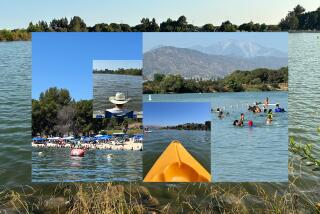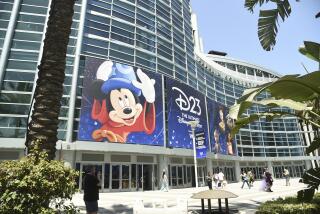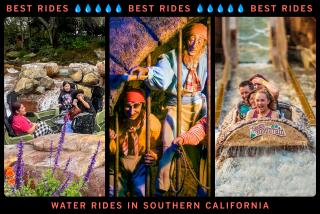Right climate for water parks
- Share via
The gates had not yet opened at Raging Waters in San Dimas on a recent sunny morning, but assistant Girl Scout leader Brenda Mauss was already in the parking lot urging her five charges to slather on the sunscreen.
The plan was to be in line for the 10 a.m. opening to wring every drop of pleasure from the day. Admission to the water park — the state’s largest — costs $36.99. But Mauss had discount coupons from a fast-food restaurant that knocked 10 bucks off each ticket.
“Everybody is looking for savings and something fun to do,” she said, as swarms of families scrambled past them toward the park entrance.
A sluggish economy is buoying business at the nation’s water parks. Though attendance at major theme parks has taken a hit, water parks are seeing an uptick thanks to families on “stay-cation,” relatively cheap admission prices and steady business from summer day camps.
“Surveys have shown that water parks are supported by Joe Lunch Pail and his family,” said William Haralson, a New Mexico-based economics consultant to theme parks, water parks and other attractions. “Water parks compared to a lot of other things are very inexpensive.”
Attendance at North America’s largest theme parks declined 1.3% last year from 2008, but it was up 3% at water parks, according to a report published by the Themed Entertainment Assn., a trade group representing designers and builders of amusement parks. Growth was even more dramatic before the recession. From 2005 to 2009, attendance at the largest North American water parks swelled by about 11%, compared with less than 3% at big theme parks.
Operators in Southern California declined to reveal exact figures for their individual properties. But they said attendance remained strong because of good weather so far this summer, affordable admission prices and multimillion-dollar expansions that have made water parks the hot place to stay cool.
The Southland’s recent heat wave has given an extra boost to the water parks. The 1,000-space parking lot at Raging Waters has been filling up daily within an hour of the park’s opening, forcing visitors to park in the outlying reserve lots.
As temperatures reached into the 90s in Orange County on Wednesday, Knott’s Soak City in Buena Park says it marked the highest attendance numbers so far this season.
“When the temperature rises, attendance goes up and we love it,” said Raging Waters spokeswoman Mary Papadopoulos. “We are packed.”
Tight economic times mean more families are staying home for summer vacation. That’s a big plus for water parks, which depend largely on locals. At Six Flags Hurricane Harbor in Valencia, 63% of the guests live within 15 miles of the park, said park spokeswoman Sandra Daniels.
To attract stay-cationers, Knott’s Soak City has reduced the prices of its season passes, charging $60 for adults and $50 for children under 12 — a $15 discount from 2009. That has boosted sales by about 50%, said spokeswoman Jennifer Blazey.
“Our numbers have been really good this year,” Blazey added.
Southern California is home to nine water parks, all competing for a piece of the lucrative summer entertainment dollar. Like traditional theme parks, water parks generate return business by upgrading their rides regularly, creating what amounts to a water-park arms war.
At Knott’s Soak City, thrill seekers gravitate to such attractions as Pacific Spin. Built in 2006, the ride hurls up to four people clinging to a raft into what looks like a giant funnel lying on its side. The combination of rushing water and momentum sends the riders sliding up and down the steep walls of the funnel, much like skateboarders in a half-pipe.
Raging Waters upped the ante this summer by opening Dr. Von Dark’s Tunnel of Terror. The ride is similar to Pacific Spin, except riders slip and slide in complete darkness.
Lindsay Fugate, 24, and three friends from Ventura pulled into the Raging Waters parking lot on a recent morning to test their courage. Roller coasters and high-tech attractions at other theme parks would be fun alternatives, but she said she couldn’t afford the $72 admission to Disneyland or the $54 ticket to see the new 3-D King Kong attraction at Universal Studios Hollywood.
“Those parks cost a pretty solid chunk of change,” she said, adding that she and her friends came across discount coupons for the water park.
Water parks also draw big business from summer camps and day-care operators looking for inexpensive ways to entertain kids. Each summer, more than 300 children enrolled in Los Angeles County’s day camp program in the Santa Clarita and Antelope Valley areas take field trips to Raging Waters and Hurricane Harbor.
“We go because it’s fun and the kids love it,” said Regina Bradley, a recreation services leader for the county. Besides, she said, the water parks offer big discounts for the groups, dropping the admission price to about $20 a child.
Water parks are also generating revenue by renting out private cabanas to parents who want to relax in the shade while their kids go crazy in the water. Knott’s Soak City charges $99 to $195 for cabanas with lounge chairs and picnic tables. At Raging Waters, guests who rent a premium cabana ($150 to $170 a day) can get food and drinks brought to them by a park server.
But affordable admission remains the biggest draw.
Raging Waters sells two season passes for $99.99. That works out to less than half the price of season admission to Disneyland, Southern California’s most popular theme park, which charges locals $108 for a pass.
“Fifty dollars for a whole summer is really cheap,” said Jayvin Marrs of Orange County, who brought his sons Ashton, 7, and Dylan, 8, to Raging Waters recently.
Some thrifty visitors save on concessions by hosting tailgate parties in the parking lot.
For water park operators, the cost to expand or build a new park is often only a fraction of the investment required for a traditional theme park, and the payoff can be substantial if the weather cooperates.
Six Flags Magic Mountain in Valencia spent $10 million in 2009 to build a single roller coaster: Terminator Salvation. Meanwhile, the operators of Legoland built an entire water park for $12 million on 5.5 acres of property adjacent to the theme park in Carlsbad.
Adult guests who pay the regular admission fee of $67 at Legoland can get into the water park for an extra $12. The facility has been open just a few weeks, but “so far, the overall reaction has been positive,” said general manager Peter Ronchetti.
But profits aren’t a slam dunk. The operating season is short — typically June, July and August. And bad weather hurts the bottom line.
Last year several East Coast water parks reported a sharp drop in attendance because of unusually chilly summer temperatures and frequent storms.
So far this year Southern California’s sunny weather has kept water park operators smiling.
“So much of our attendance is driven by the sun,” said Papadopoulos of Raging Waters. “When I get up in the morning and see the sun, I do my sun dance.”
More to Read
Sign up for Essential California
The most important California stories and recommendations in your inbox every morning.
You may occasionally receive promotional content from the Los Angeles Times.









